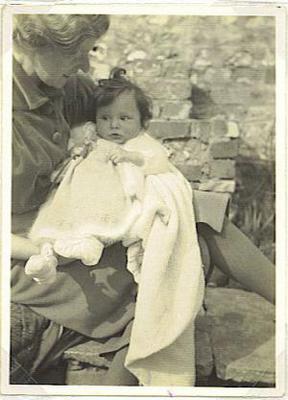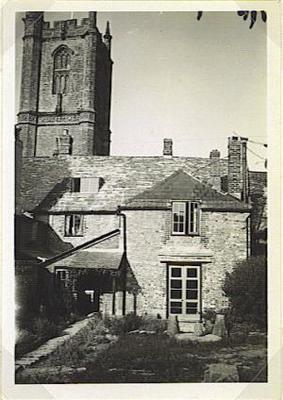CERNE ABBAS 1940-1945. (2)
My early memories have stayed clear in my mind, and remain like vivid snapshots.
The earliest of these is of one sunny summer afternoon, sitting in my high-chair by the french window in the room next to the kitchen at the Pitchmarket. My high-chair, which was made of a light coloured wood, had legs which hinged half way down so that they could be folded in half - so making the seat at floor level, with the panel at the base of the chair upturned to form a large tray in front of me, with two rows of coloured wooden beads down each side, and plenty of room for my toys.
As I sat there, diagonally facing and to the right of the window, with the afternoon sunshine pouring through, I can very clearly remember thinking that this was much better than the chair's usual upright position, wondering why it had not been thought of before, and hoping it would happen again!


I can just about remember sitting up in my pram - a lovely shiny black affair - and can certainly remember seeing it stored away in what was then a lumber room over the passageway between the Pitchmarket and Abbey Cottage. I wanted to climb back into it, but it was too high to do so.
The passageway was a shared access between the two houses to their gardens at the rear. Abbey Cottage was owned by a Mr Beresford, who was my parents' landlord. The relationship seems to have been an acrimonious one, starting with some sort of dispute to do with drains in October 1939, continuing in February 1940 with an argument over the key of the passageway, with further threatening correspondence in February 1942. It must have been a relief to all concerned when in October 1944 Abbey Cottage was sold privately to a retired tea-planter from Assam with a young wife and son, aged two, with whom I used to play. I can just remember him - I think he had red hair.
My best friend at the time was Penelope Fry. She and her mother lived at 6 Abbey Street. I'm not sure if her mother was a widow, or if her husband was away in the Services, but later I was told that she had a reputation for consorting with the American soldiers. I wrote a little story for Penelope on her fourth birthday about a farmer and his ducklings, which I also illustrated.
Many years later, when she was a student nurse at the Westminster hospital, she became a lodger of an old school friend of mine, Rachel MacOwen, through whom she returned the little book to me - but we never met again after I left Cerne in 1945.
My bedroom at the Pitchmarket was at the back of the house overlooking the garden, and my parents had the one in the front. On one occasion, a foot of their four-poster bed came through the ceiling of the floor below. There was a gate at the top of the stairs to prevent me falling down them when I was learning to walk. I can just remember being in my drop-sided cot in a small narrow room next to my parents' bedroom. I was moved to a proper bed in the bedroom in July 1944.


Whenever I was a bit poorly, or generally just out of sorts, my mother would resort to dosing me with a horrible-tasting cure-all in which she showed great faith: Steadman's Powders. Each dose, which came in its own individually folded piece of white paper, would be mixed with water and given to me to drink.
There was a small red booklet containing advice on the treatment of all possible ailments from Croup to Whooping-Cough, most of which, it stated, could be successfully treated by a timely dose of Steadman's Powders - although for the more serious illnesses, such as Diphtheria, it was recommended that one should "call a doctor immediately", in heavy type. The booklet also contained photographs of healthy happy children, with letters from their equally happy looking mothers who were so pleased with the miraculous results of using these foul-tasting powders.
I hated and dreaded having to take them.
On one occasion, I was sitting up in bed when a glass containing that night's dose was handed to me. As soon as my mother had left the room I spat it out, all over the wall. There was no way of disguising what I had done. Another dose was prepared, and my mother stood over me while I swallowed it.


I have much fonder memories of the garden where I used to play. My parents grew vegetables throughout the War, strawberries and raspberries too, and there were several apple trees; but my mother, always a keen gardener, grew lots of flowers as well. I had my own small wheelbarrow, which got lost in the move to Belfield later on.
I can remember sitting on my mother's knee while she taught me to read, and how excited I felt when one day I suddenly discovered I could read on my own.
<< Previous post · First post · Next post >>
The earliest of these is of one sunny summer afternoon, sitting in my high-chair by the french window in the room next to the kitchen at the Pitchmarket. My high-chair, which was made of a light coloured wood, had legs which hinged half way down so that they could be folded in half - so making the seat at floor level, with the panel at the base of the chair upturned to form a large tray in front of me, with two rows of coloured wooden beads down each side, and plenty of room for my toys.
As I sat there, diagonally facing and to the right of the window, with the afternoon sunshine pouring through, I can very clearly remember thinking that this was much better than the chair's usual upright position, wondering why it had not been thought of before, and hoping it would happen again!


I can just about remember sitting up in my pram - a lovely shiny black affair - and can certainly remember seeing it stored away in what was then a lumber room over the passageway between the Pitchmarket and Abbey Cottage. I wanted to climb back into it, but it was too high to do so.
The passageway was a shared access between the two houses to their gardens at the rear. Abbey Cottage was owned by a Mr Beresford, who was my parents' landlord. The relationship seems to have been an acrimonious one, starting with some sort of dispute to do with drains in October 1939, continuing in February 1940 with an argument over the key of the passageway, with further threatening correspondence in February 1942. It must have been a relief to all concerned when in October 1944 Abbey Cottage was sold privately to a retired tea-planter from Assam with a young wife and son, aged two, with whom I used to play. I can just remember him - I think he had red hair.
My best friend at the time was Penelope Fry. She and her mother lived at 6 Abbey Street. I'm not sure if her mother was a widow, or if her husband was away in the Services, but later I was told that she had a reputation for consorting with the American soldiers. I wrote a little story for Penelope on her fourth birthday about a farmer and his ducklings, which I also illustrated.
Many years later, when she was a student nurse at the Westminster hospital, she became a lodger of an old school friend of mine, Rachel MacOwen, through whom she returned the little book to me - but we never met again after I left Cerne in 1945.
My bedroom at the Pitchmarket was at the back of the house overlooking the garden, and my parents had the one in the front. On one occasion, a foot of their four-poster bed came through the ceiling of the floor below. There was a gate at the top of the stairs to prevent me falling down them when I was learning to walk. I can just remember being in my drop-sided cot in a small narrow room next to my parents' bedroom. I was moved to a proper bed in the bedroom in July 1944.


Whenever I was a bit poorly, or generally just out of sorts, my mother would resort to dosing me with a horrible-tasting cure-all in which she showed great faith: Steadman's Powders. Each dose, which came in its own individually folded piece of white paper, would be mixed with water and given to me to drink.
There was a small red booklet containing advice on the treatment of all possible ailments from Croup to Whooping-Cough, most of which, it stated, could be successfully treated by a timely dose of Steadman's Powders - although for the more serious illnesses, such as Diphtheria, it was recommended that one should "call a doctor immediately", in heavy type. The booklet also contained photographs of healthy happy children, with letters from their equally happy looking mothers who were so pleased with the miraculous results of using these foul-tasting powders.
I hated and dreaded having to take them.
On one occasion, I was sitting up in bed when a glass containing that night's dose was handed to me. As soon as my mother had left the room I spat it out, all over the wall. There was no way of disguising what I had done. Another dose was prepared, and my mother stood over me while I swallowed it.


I have much fonder memories of the garden where I used to play. My parents grew vegetables throughout the War, strawberries and raspberries too, and there were several apple trees; but my mother, always a keen gardener, grew lots of flowers as well. I had my own small wheelbarrow, which got lost in the move to Belfield later on.
I can remember sitting on my mother's knee while she taught me to read, and how excited I felt when one day I suddenly discovered I could read on my own.
<< Previous post · First post · Next post >>


4 Comments:
Dear Mike's mum, today being Sunday, I will read your delightful blog.
How old were you when you had that high-chair thought?
Interesting, just last night I was saying to our dinner guests that it's amazing how far back our memory goes...and how events, people, places make a lasting impression on us from a very tender age.
Infantile amnesia was in the news again last month. I think it was prompted by the release of another study confirming earlier ones that show three-years-old seems to be about as far back as most of us can go and even at that age, the memories are framentary and sparse.
These memories are charming. More please.
Guyana-Gyal: Unfortunately, my mum isn’t on the Internet; she doesn’t even have a computer! I’ll ask her your question the next time I speak to her. Anyway, I'm glad you’re enjoying her writing.
Asta: Speaking for myself, my earliest clear memory dates from when I was about 2 years and 6 months old, and I have quite a few clear memories of the house I lived in until I was 3 years and 7 months old.
Update: My mother thinks that the high chair memory dates from when she was about 18 months old.
Post a Comment
<< Home